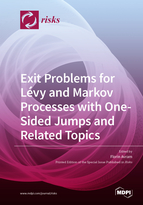Exit Problems for Lévy and Markov Processes with One-Sided Jumps and Related Topics
A special issue of Risks (ISSN 2227-9091).
Deadline for manuscript submissions: closed (30 September 2019) | Viewed by 32067
Special Issue Editor
Interests: stochastic processes; risk; mathematical finance; inventory; queueing and population dynamics
Special Issues, Collections and Topics in MDPI journals
Special Issue Information
Dear Colleagues,
It has long been well-known that exit problems for one-dimensional Lévy processes are easier when there are jumps in one direction only. In the last few years, this intuition became more precise: We know now that a great variety of identities for exit problems of spectrally-negative Lévy processes may be ergonomically expressed in terms of two “q-harmonic functions” (or scale functions, or positive martingales) W and Z. The proofs typically require not much more than the strong Markov property and hold in principle for the wider class of spectrally-negative strong Markov processes. This has been established already in particular cases, such as random walks, Markov additive processes, Lévy processes with Omega state dependent killing, certain Lévy processes with state dependent drift, and seems to be true for general strong Markov processes, subject to technical conditions. However, computing the functions W, Z is still an open problem outside the Lévy and diffusion classes, even for the simplest risk models with state-dependent parameters (say, Ornstein-Uhlenbeck or Feller branching diffusion with phase-type jumps).
Motivated by these considerations, this Special Issue aims to review and push further the state-of-the-art on the following topics:
- W, Z formulas for exit problems of the Lévy and diffusion classes (including drawdown problems)
- W, Z formulas for quasi-stationary distributions
- Asymptotic results
- Extensions to random walks, Markov additive processes, Omega models, processes with Parisian reflection or absorbtion, processes with state-dependent drift, etc.
- Optimal stopping, dividends, real options, etc
- Numeric computation of the scale functions
Prof. Dr. Florin Avram
Guest Editor
Manuscript Submission Information
Manuscripts should be submitted online at www.mdpi.com by registering and logging in to this website. Once you are registered, click here to go to the submission form. Manuscripts can be submitted until the deadline. All submissions that pass pre-check are peer-reviewed. Accepted papers will be published continuously in the journal (as soon as accepted) and will be listed together on the special issue website. Research articles, review articles as well as short communications are invited. For planned papers, a title and short abstract (about 100 words) can be sent to the Editorial Office for announcement on this website.
Submitted manuscripts should not have been published previously, nor be under consideration for publication elsewhere (except conference proceedings papers). All manuscripts are thoroughly refereed through a single-blind peer-review process. A guide for authors and other relevant information for submission of manuscripts is available on the Instructions for Authors page. Risks is an international peer-reviewed open access monthly journal published by MDPI.
Please visit the Instructions for Authors page before submitting a manuscript. The Article Processing Charge (APC) for publication in this open access journal is 1800 CHF (Swiss Francs). Submitted papers should be well formatted and use good English. Authors may use MDPI's English editing service prior to publication or during author revisions.
Keywords
- Exit/first passage problems
- Levy processes
- Diffusions
- Scale functions
- Drawdown/trailing stop
- State-dependent parameters
- Excursion theory
- Phase-type distributions
- Hypergeometric functions
- Optimal control






